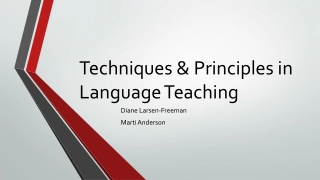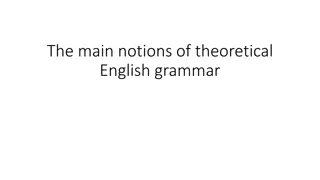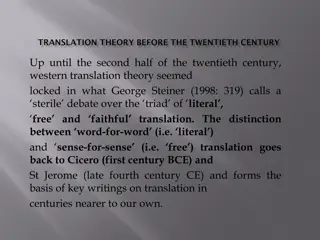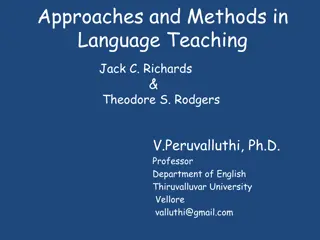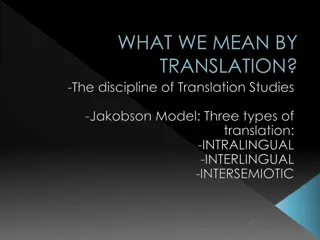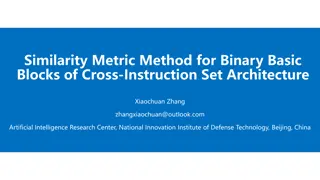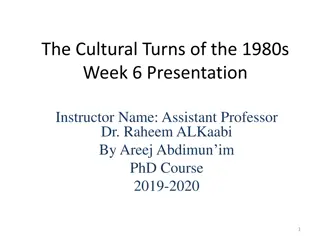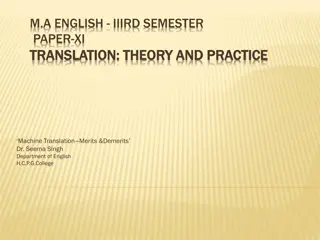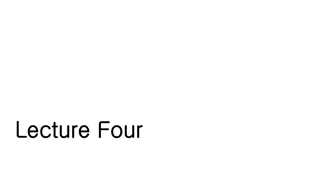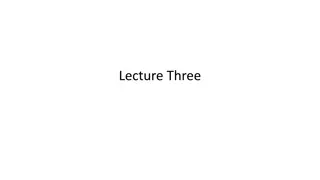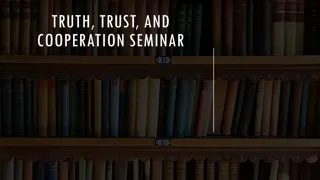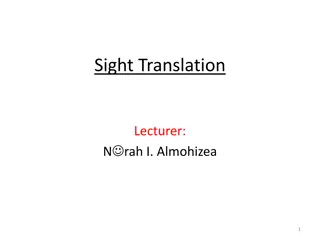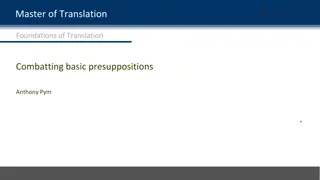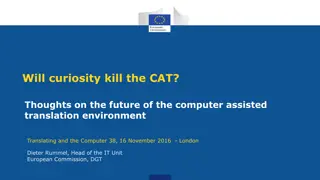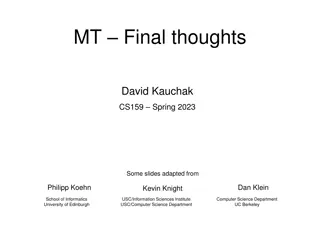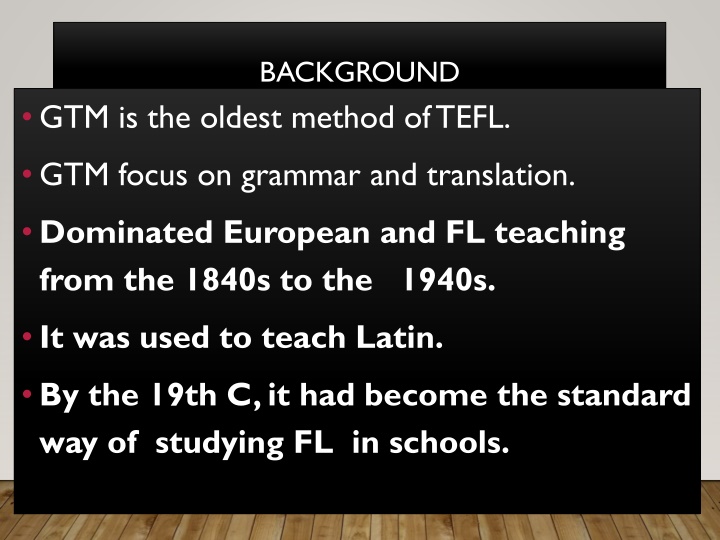
Decoding Grammar Translation Method (GTM) in Language Teaching
Uncover the historical background, key features, and educational purpose of the Grammar Translation Method (GTM) in language teaching. Explore how GTM emphasizes grammar, translation, and mental discipline to access literature in the target language, with a focus on accuracy and grammar rules. Discover the methodology, stages, and goals of GTM, highlighting its use of L1, grammar instruction, and teaching through bilingual word lists for developing reading and writing skills.
Download Presentation

Please find below an Image/Link to download the presentation.
The content on the website is provided AS IS for your information and personal use only. It may not be sold, licensed, or shared on other websites without obtaining consent from the author. If you encounter any issues during the download, it is possible that the publisher has removed the file from their server.
You are allowed to download the files provided on this website for personal or commercial use, subject to the condition that they are used lawfully. All files are the property of their respective owners.
The content on the website is provided AS IS for your information and personal use only. It may not be sold, licensed, or shared on other websites without obtaining consent from the author.
E N D
Presentation Transcript
BACKGROUND GTM is the oldest method of TEFL. GTM focus on grammar and translation. Dominated European and FL teaching from the 1840s to the 1940s. It was used to teach Latin. By the 19th C, it had become the standard way of studying FL in schools.
TFLs goes thru 2 stages (Richard & Rodgers, 1986) : A) , Ts teach grammatical rules and B) present a vocab list to SS. SS apply what they have learnt in Translation exercices.
Latin was not leant as an end in itself but as a tool to achieve 2 things : 1. Being able to translate and understand old texts. 2. To develop mental discipline.
FEATURES The use of L1 as a means of communication and instruction in the classrom The focus is put on the gramatical rules Excercises revolve around the translation of old texts from the L1 to TL and vice versa. A lot of importance is given to reading and writing. Ts have full authority in the classroom. SS were supposed to absorb everything presented to them. Being accurate is more important that being fluent.
PURPOSE OF GTM to be able to read literature written in the target language; -to provide students with good mental exercise which helps develop their minds; - to give the learners grammatical rules and examples to memorize them; - to make them apply the rules to other examples; - to teach the students to write in both their native and the target languages through translation. (B rdos 2005: 46)
The sentence is the basic unit of teaching and language practice. Accuracy is emphasised. Grammar is taught deductively. The S NL is the medium of instruction. Vocab selection is based solely on the reading texts used, and words are taught through bilingual word lists, dictionary study and memorization.
The goal of learning a FL is to get access to its literature. The GTM views lge learning as consisting of little more than memorizing rules and facts in order to understand and manipulate the morphology and syntax of the FL. Develops R & W.
ADVANTAGES GTM is an easy method to apply. People who learn the TL under GTM are known for their good writing (Mukalel, 2007). The T shouldn t be that competent in the TL. Its suitable for large classes. The use of the L1 will not create a linguistic problems b/w the T and the S. SS become aware of their L1.
An effective way for application of grammar and sentence structure. Few demands on teachers ( perhaps the excact reason of its popularity). Least stressful for students.
DISADVANTAGES Teaching is about the language not the language itself. Interaction between the students and the teacher is absent. Creativity is absent. The use of L1 keeps SS under its dominance. Its techniques are limited. Mistakes are not tolerated. Little attention is paid to the content of the text
Wrong idea of what language is. Less learners motivation. Create frustration for learners. Language is seen as a collection of words which are isolated and independent. So, SS themselves are not seemingly able to produce sentences. SS cannot master of all 4 lge skills of English.
APPLICATION: TYPICALTECHNIQUES Translation of literary texts. Reading comprehension questions. Antonyms/ Synonyms. Cognates. Deductive application of rules. Fill-in-the-blanks. Memorization. Use words in sentences. Composition.
PROCEDURES Activity 1 Reading Comprehension The class begins with a reading passage from the foreign language literature. Each student is called upon to read a few lines from the passage, then they translate into their mother tongue the few lines they have just read. The teacher helps them with suitable translations in case they lack the required vocabulary.
ACTIVITY II: VOCABULARY Students turn to a list of words taken from the passage, and are asked to give the mother tongue equivalent for each one of them.This is conducted as a whole class activity. If no one knows the equivalent of a certain word,the teacher provides it. Students are given another list of words from the passage and are asked to provide the opposites of these words (antonyms). The same procedure is repeated with words that look the same in English and Arabic (cognates). Students are asked to search the passage for examples of cognates and to translate them into their mother tongue.
ACTIVITY III : GRAMMAR The teacher reads a list of two-word verbs (phrasal verbs). He begins with simple phrasal verbs, then moves to new phrasal verbs in the passage. Students are asked to translate them into their mother tongue. Then, they are given the rule of a direct object with two- word verbs (separable vs.inseparable phrasal verbs). Students are asked to tell which of the following two-word verbs are separable and which are not They are asked to fill in the blanks with one of these phrasal verbs.
ACTIVITY IV: WRITING Students are asked to write a composition in the target language applying the information in the passage to some similar topic.
CONCLUSION The GTM was still widely practiced til the 1950 , despite the fact that it wasn t based on any theory and hadn t any justification relating it to linguistics, psychology, or educational theory. In the 1950 , the opposition of the GMT developed in Europe Many teaching methods emerged.

